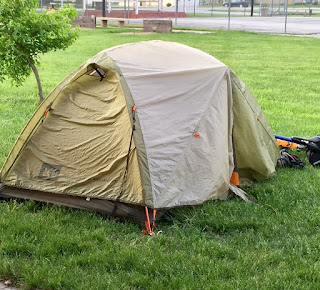My grandfather used to have a plaque at his cabin that read something to the effect that, "Indian men went hunting and fishing while Indian women did all of the work. White men thought they could improve upon that system! "
Most of the Mandan earth lodges that Lewis and Clark encountered in the upper Missouri River Valley had been abandoned. The Mandan population was decimated by a smallpox epidemic three decades earlier and the surviving Mandans migrated north along the River. (My guess is that they went north to distance themselves from their enemies, the Teton Sioux, to the south. It certainly was not a climate-driven decision!) By the time Lewis and Clark arrived the Mandan population was only about 1,200.


The photographs above are from a re-creation of a large Mandan village that was located near the present day town of Mandan. Local Sioux told Lewis and Clark that the village had been abandoned for about 25 years.
Lewis and Clark finally stopped for the winter of 1804-05 at the end of October near Washburn, ND, where they hastily built a fort across the River from two Mandan and three Hidatsa villages. Upon their arrival, Mandan Chief Sheheke-shote (White Coyote ), whom Lewis and Clark called "Big White", famously told the Corps of Discovery, "If we eat you shall eat, if we starve, you must starve also."

Fort Mandan became a popular hangout for the Native American neighbors over the course of the bitterly cold winter that ensued. The Native Americans shared their food generously and many of the men of the Corps of Discovery became close to Native American women.

This a replica of the fort near the site of Fort Mandan.
Lewis and Clark employed a French for trader who had been living in one of the Hidatsa villages,Toussaint Charbonneau, to serve as a translator on the upcoming leg of their journey.
Upon learning that she was a Shoshone, a tribe they knew they would encounter on the eastern edge of the mountains,Lewis and Clark permitted Charbonneau to bring along one of his two Indian wives, 16-year old Sacagawea. Sacagawea gave birth to the couple's son (Jean Baptiste Charbonneau, whom Clark nicknamed Pomp) at Fort Mandan in February 1805. Lewis later described Charbonneau as a man of no great virtues, but Sacajawea would prove herself valuable to the expedition.

The above statue of Sacajawea and Pomp is located near the North Dakota State Capitol.
I have decided that Fort Mandan is an appropriate spot to end the first year of my Lewis and Clark bicycle journey. I look forward to resuming and completing my journey in 2017! My wife has assured me that if she eats this winter, I shall eat also!













































 It rained again last night and all morning, so I explored the historic and charming town of Excelsior Springs. In much of the 19th and 20th centuries, people came to Excelsior Springs from all over the Midwest and beyond seeking the curative affects of a variety of mineral waters from various springs around Excelsior Springs.
It rained again last night and all morning, so I explored the historic and charming town of Excelsior Springs. In much of the 19th and 20th centuries, people came to Excelsior Springs from all over the Midwest and beyond seeking the curative affects of a variety of mineral waters from various springs around Excelsior Springs. 
 This all came to a crashing halt in 1963 when a gentleman seeking a cure for his arthritis visited Excelsior Springs and a variety of other towns that touted curative effects from their mineral springs. Not feeling cured and unhappy with the cost of treatment, the gentleman wrote a scathing feature story in the Saturday Evening Post debunking the myth that mineral waters contained curative qualities.
This all came to a crashing halt in 1963 when a gentleman seeking a cure for his arthritis visited Excelsior Springs and a variety of other towns that touted curative effects from their mineral springs. Not feeling cured and unhappy with the cost of treatment, the gentleman wrote a scathing feature story in the Saturday Evening Post debunking the myth that mineral waters contained curative qualities.